
Looking for Loquat Jelly - How to Make Loquat Jelly - Easilt, Step-by-Step, with Photos in 2025? Scroll down this page and follow the links. And if you bring home some fruit or vegetables and want to can, freeze, make jam, salsa or pickles, see this page for simple, reliable, illustrated canning, freezing or preserving directions. There are plenty of other related resources, click on the resources dropdown above. If you are having a hard time finding canning lids, I've used these, and they're a great price & ship in 2 days.
If you have questions or feedback, please let me know! There are affiliate links on this page. Read our disclosure policy to learn more.
Loquat Jelly - How to Make Loquat Jelly - Easilt, Step-by-Step, with Photos
Yield: 4 to 5 half-pint jars
Click here for a PDF print version
Loquats are a tropical fruit from China with a flavor that is a mix of peach,
citrus and mild mango. Loquats make exellent jelly, fruit butter, salsa and
chutneys. The flowers appear in the autumn or early winter, and the fruits
are ripe in late winter or early spring.
Loquat fruits, growing in clusters, are oval, rounded or pear-shaped, 3-5 cm
long, with a smooth or downy, yellow or orange, sometimes red-blushed skin
have a succulent, tangy flesh that is white, yellow or orange and sweet to subacid
or acid, depending on the variety. The fruits are the sweetest when soft and
orange. Making and canning your own Loquat jelly is easy.
Ingredients
- 4 cups loquat juice - It takes about 4 dozen loquats to make 4 cups of strained juice.
- Pectin - 1 package (box usually) or if you get it in bulk, 8 Tablespoons, see the directions below for specifics - (it's a natural product, made from apples and available at grocery stores (season - spring through late summer) and local "big box" stores. It usually goes for about $2.00 to $2.50 per box. You will get best results with no-sugar needed pectin, whether you choose to add sugar or not! See here for more information about how to choose the type of pectin to use.
- Jar funnel ($5 at Target, other big box stores, and often grocery stores; and available online - see this page) or order it as part of the kit with the Jar grabber .
- Sugar - About 4 cups of dry, granulated (table) sugar. Yes, you can substitute an equivalent amount of honey or agave. For the no-sugar recipe, click here
Equipment
- At least 1 large pot; I prefer 16 to 20 quart Nonstick ceramic coated (taking care not to overheat the pots) pots for easy cleanup.
- Large spoons and ladles,
- 1 Water Bath Canner (a huge pot to sanitize the jars after filling (about $30 to $35 at mall kitchen stores, sometimes at big box stores and grocery stores.). Note: we sell canners and supplies here, too - at excellent prices - and it helps support this web site!
- Ball jars (Grocery stores, like Publix, Kroger, Safeway carry them, as do some big box stores - about $7 per dozen 8 ounce jars including the lids and rings)
- Lids - thin, flat, round metal lids with a gum binder that seals them against the top of the jar. They may only be used once.
- Rings - metal bands that secure the lids to the jars. They may be reused many times.
- Jelly bag - to seive the cooked juice. Cheesecoth or even a sterilized white T-shirt can work in a pinch, but a jelly bag and stand is deigned for the purpose and works better with less waste. See example at below right with ordering information.
- Jar grabber (to pick up the hot jars)- Big box stores and grocery
stores sometimes carry them; and it is available online - see this page.
It's a tremendously useful to put jars in the canner and take the hot jars
out (without scalding yourself!). The kit sold below has everything you
need, and at a pretty good price:
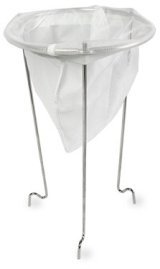 See here for related tools, equipment, supplies on Amazon
See here for related tools, equipment, supplies on Amazon
See here for related tools, equipment, supplies on Amazon
Directions - Step by Step
Step 1 - Wash the jars and lids
 Now's
a good time to get the jars ready, so you won't be rushed later. The dishwasher
is fine for the jars; especially if it has a "sanitize" cycle, the water bath
processing will sanitize them as well as the contents! If you don't have a
dishwasher with a sanitize cycle, you can wash the containers in hot, soapy
water and rinse, then sanitize the jars by boiling them 10 minutes, and keep the
jars in hot water until they are used.
Now's
a good time to get the jars ready, so you won't be rushed later. The dishwasher
is fine for the jars; especially if it has a "sanitize" cycle, the water bath
processing will sanitize them as well as the contents! If you don't have a
dishwasher with a sanitize cycle, you can wash the containers in hot, soapy
water and rinse, then sanitize the jars by boiling them 10 minutes, and keep the
jars in hot water until they are used.
NOTE: If a canning recipe calls for 10 minutes or more of process time in the canner, then the jars do not need to be "sanitized" before filling them.
But really, sanitizing them first is just good hygeine and common sense! See this page for more detail about cleaning and sanitizing jars and lids.
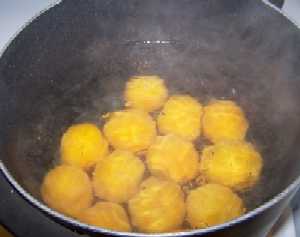
Put the lids into a pan of hot, but not quite boiling water (that's what the manufacturer's recommend) for 10 minutes, and use the magnetic "lid lifter wand" to pull them out. Leave the jars in the dishwasher on "heated dry" until you are ready to use them. Keeping them hot will prevent the jars from breaking when you fill them with the hot jam.
Step 2 - Prepare the loquats
Select full size loquats that are still firm. Wash the loquats in cool water. Cut in half and remove the seeds and blossom ends. Chop them in to 1/2 inch (1 cm) pieces.
Step 3 - Measure out your choice of sweetener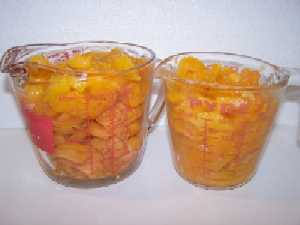
Depending upon which type of jelly you're making (sugar, no-sugar, Stevia (but you will have to experiment with amount, each brand of Stevia is a different concentration), or Splenda, or a mix of sugar and Stevia (or Splenda) or fruit juice) you will need to use a different amount of sugar and type of pectin. The precise measurements are found in directions inside each and every box of pectin sold (every brand, Ball, Kerr, Mrs. Wages, etc. has directions inside). I don't recommend using Stevia (in a prepared form like Truvia, it measures same as sugar; if you use another form, you will need do your own conversion) - or Splenda, if you prefer, by itself - plain old sugar makes a big difference in the color and taste. Unless you're diabetic, for best results, try the low or lower sugar formula below.
| Type of jam |
Type of pectin to buy |
Sweetener |
| regular | no-sugar or regular | 7 cups of sugar |
| low sugar | no-sugar | 4.5 cups of sugar |
| lower sugar | no-sugar | 2 cups sugar and 2 cups Splenda (or about 1/3 that if you use Stevia, which is my preference) |
| no sugar | no-sugar | 4 cups Splenda (or about 1/3 that if you use Stevia, which is my preference) |
| natural | no-sugar | 3 cups fruit juice (grape, peach, apple or mixed) |
Step 4 - Mix the dry pectin with about 1/4 cup of sugar or other sweetener
Keep this separate from the rest of the sugar. If you are not using
sugar, you will just have to stir more vigorously to prevent the pectin from
clumping.
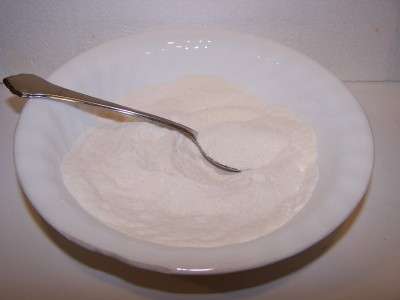
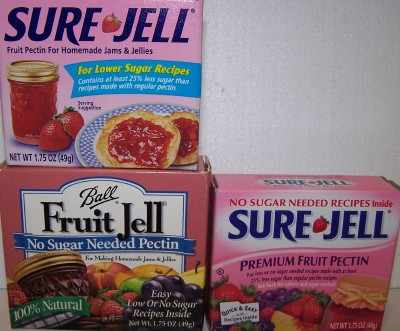 For more about the types of pectin sold,
see this page!
For more about the types of pectin sold,
see this page!

Is your jelly too runny? Pectin enables you to turn out perfectly set jelly
every time. Made from natural apples, there are also natural no-sugar
pectins that allow you to reduce the sugar you add by half or even eliminate
sugar.!
Get them all here at the best prices on the internet!
Step 5 - Cook the chopped loquats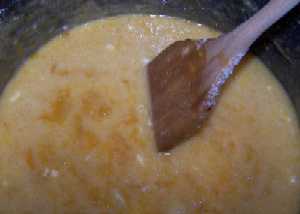
Place in a saucepan and barely cover with cold water. Cook slowly until pulp is very soft. Stir to prevent scorching.
Step 6 - Seive/filter the cooked loquats
When fruit is soft, pour everything through a double layer of
dampened cheesecloth or a damp jelly bag. Suspend the bag over a bowl or
pan, using a stand or colander to hold the bag. Drain the juice without
pressing or squeezing, which will cause cloudy jelly. If a fruit press is
used, the juice should be restrained through a jelly bag.
Step 7 - Add the pectin to the hot strained juice and bring to a full boil
Stir the pectin into the loquat juice and put the mix in a big pot on the stove over medium to high heat (stir often enough to prevent burning). It should take about 5 to 10 minutes to get it to a full boil (the kind that cannot be stirred away).
Notes about pectin: some people don't use pectin with loquats, since they contain a high level of pectin. I add to ensure a good gel. I use the low sugar or no-sugar pectin. It cuts the amount of sugar you need from 7 cups per batch to 4 cups. And it tastes even better! On the other hand; I still add some sugar, even with the No-sugar pectin. With no added sugar, the batches always turned out runny and bland. You might want to try using the low sugar recipe with a mixture of sugar and Stevia (or if you prefer, agave, honey or Splenda); that could work, but you do get the best results with sugar.
Step 8 - Add the remaining sugar and bring to a boil
 When
the berry-pectin mix has reached a full boil, add the rest of the sugar or other sweetener,
and then bring it back to a boil and boil hard for 1 minute.
When
the berry-pectin mix has reached a full boil, add the rest of the sugar or other sweetener,
and then bring it back to a boil and boil hard for 1 minute.
Step 9 - Remove from heat and test for "jell" (thickness)
I
keep a metal tablespoon sitting in a glass of ice water, then take a
half spoonful of the mix and let it cool to room temperature on the
spoon. If it thickens up to the consistency I like, then I know the jam
is ready. If not, I mix in a little more pectin (about 1/s to 1/2 of
another package) and bring it to a boil again for 1 minute.
Step 10 - Fill the jars and put the lid and rings on
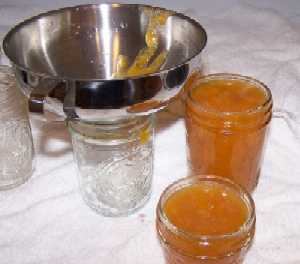 Fill
them to within 1/4-inch of the top, wipe any spilled jelly off the top, seat
the lid and tighten the ring around them. Then put the filled jars into the canner!p>
This is where the jar tongs and lid lifter come in really handy!
Fill
them to within 1/4-inch of the top, wipe any spilled jelly off the top, seat
the lid and tighten the ring around them. Then put the filled jars into the canner!p>
This is where the jar tongs and lid lifter come in really handy!

Step 11 - Process the jars in the boiling water bath
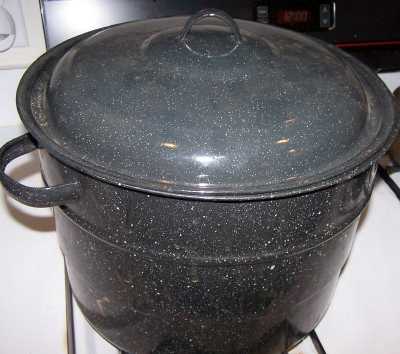 Keep
the jars covered with at least 2 inches of water. Keep the water
boiling. In general, boil them for 5 minutes. I say "in general"
because you have to process (boil) them longer at higher altitudes than
sea level, or if you use larger jars, or if you did not sanitize the
jars and lids right before using them. The directions inside every
box of pectin will tell you exactly. The directions on the pectin
tend to be pretty conservative. Clemson University says you only
need to process them for 5 minutes. I usually hedge my bets and
start pulling them out after 7 minutes, and the last jars were probably
in for 10. I rarely have a jar spoil, so it must work.
Keep
the jars covered with at least 2 inches of water. Keep the water
boiling. In general, boil them for 5 minutes. I say "in general"
because you have to process (boil) them longer at higher altitudes than
sea level, or if you use larger jars, or if you did not sanitize the
jars and lids right before using them. The directions inside every
box of pectin will tell you exactly. The directions on the pectin
tend to be pretty conservative. Clemson University says you only
need to process them for 5 minutes. I usually hedge my bets and
start pulling them out after 7 minutes, and the last jars were probably
in for 10. I rarely have a jar spoil, so it must work.
Note: Some people don't even boil the jars; they just ladle it hot into hot jars, put the lids and rings on and invert them, but putting the jars in the boiling water bath REALLY helps to reduce spoilage! To me, it makes little sense to put all the working into making the jelly and then not to process the jars to be sure they don't spoil!
| Recommended process time for Loquat Jelly in a boiling water canner. | ||||
| Process Time at Altitudes of | ||||
| Style of Pack | Jar Size | 0 - 1,000 ft | 1,001 - 6,000 ft | Above 6,000 ft |
| Hot |
Half-pints or Pints |
5 min | 10 | 15 |
Step 12 - Remove and cool the jars - Done!
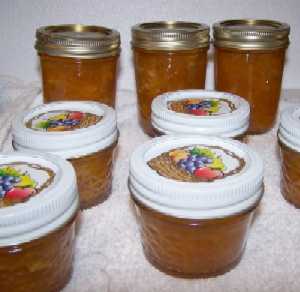 Lift
the jars out of the water and let them cool without touching or bumping
them in a draft-free place (usually takes overnight) You can then remove
the rings if you like, but if you leave them on, at least loosen them
quite a bit, so they don't rust in place due to trapped moisture. Once
the jars are cool, you can check that they are sealed verifying that the
lid has been sucked down. Just press in the center, gently, with your
finger. If it pops up and down (often making a popping sound), it is not
sealed. If you put the jar in the refrigerator right away, you can still
use it. Some people replace the lid and reprocess the jar, then that's a
bit iffy. If you heat the contents back up, re-jar them (with a new lid)
and the full time in the canner, it's usually ok.
p>Once cooled, they're ready to store. I find they last up to 12 months.
But after about 6 to 8 months, they get darker in color and start to get
runny. They still are safe to eat, but the flavor and texture aren't as
good. So eat them in the first 6 months after you prepare them!
Lift
the jars out of the water and let them cool without touching or bumping
them in a draft-free place (usually takes overnight) You can then remove
the rings if you like, but if you leave them on, at least loosen them
quite a bit, so they don't rust in place due to trapped moisture. Once
the jars are cool, you can check that they are sealed verifying that the
lid has been sucked down. Just press in the center, gently, with your
finger. If it pops up and down (often making a popping sound), it is not
sealed. If you put the jar in the refrigerator right away, you can still
use it. Some people replace the lid and reprocess the jar, then that's a
bit iffy. If you heat the contents back up, re-jar them (with a new lid)
and the full time in the canner, it's usually ok.
p>Once cooled, they're ready to store. I find they last up to 12 months.
But after about 6 to 8 months, they get darker in color and start to get
runny. They still are safe to eat, but the flavor and texture aren't as
good. So eat them in the first 6 months after you prepare them!
Other Equipment:From left to right:
|
 You can get all of the tools in a kit here: Canning kit with Stainless Steel Steam Rack,Canning Funnel, Jar Lifter, Jar Wrench, Lid Lifter, Canning Tongs, Bubble Remover Tool |
Looking for canning equipment and supplies?
Water bath canner with a jar rack
Pressure canners for gas, electric and induction stoves: Presto 23Qt or T-fal 22Qt
Canning scoop (this one is PERFECT)
Ball Blue book (most recent version)
Jars: 8oz canning jars for jams
Find Other types of farms:
Farm markets and roadside stands
Road trips and camping resources
Local Honey, apiaries, beekeepers
Consumer fraud and scams information
Home canning supplies at the best prices on the internet!
Maple Syrup Farms, sugarworks, maple syrup festivals
Environmental information and resources
Farms For Your Event for birthday parties, weddings, receptions, business meetings, retreats, etc.
Festivals - local fruit and vegetable festivals
Get the
most recent version of
the Ball Blue Book
With this Presto 23 quart pressure canner and pressure cooker, you can "can" everything, fruits, vegetables, jams, jellies, salsa, applesauce, pickles, even meats, soups, stews. Model 01781

You can make jams, jellies, can fruit, applesauce, salsa and pickles with water bath canners, like this Granite Ware 12-Piece Canner Kit, Jar Rack, Blancher, Colander and 5 piece Canning Tool Set

